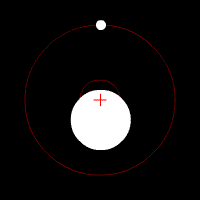Center of Mass
In physics, the center of mass (COM) of a mass or object in space is the unique point at which the weighted relative position of the distributed mass sums to zero. In this case, the distribution of mass is balanced around the center of mass and the average of the weighted position coordinates of the distributed mass defines its coordinates. Calculations in mechanics are simplified when formulated with respect to the COM.
System of Particles
In the case of a system of particles
Solve this equation for
where
Continuous Distribution
If the mass distribution is continuous with respect to the density,
Solve this equation for the coordinates
where

Two Bodies and the COM
Two bodies orbiting the COM located inside one body. COM can be defined for both discrete and continuous systems. The two objects are rotating around their center of mass.